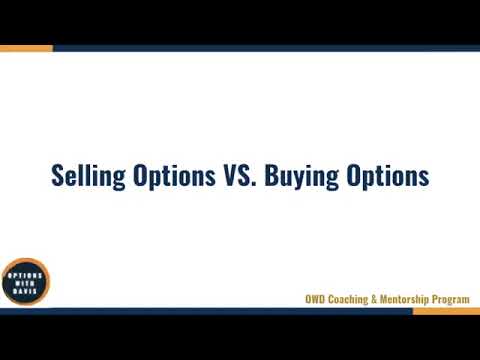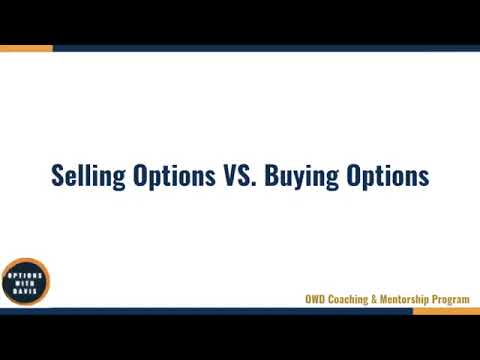In the video titled “1-3 Selling Options vs Buying Options” by Find a Service NOW, the advantages of selling options over buying options are explored. The video highlights how option sellers have a statistical edge due to the overestimated implied volatility compared to realized volatility. It also discusses the higher win rate and lower risk to reward ratio of credit strategies, as well as the potential for losing streaks in debit strategies. The video goes on to compare two bullish strategies, a credit spread (bull put spread) and a debit spread (bull call spread), emphasizing the importance of managing risk and trade well in options trading.
In this informative video, you’ll learn about the benefits of selling options versus buying options. You’ll discover how option sellers have a statistical edge and how the premium they receive is often higher due to overestimated implied volatility. The video also highlights the higher win rate and lower risk to reward ratio of credit strategies compared to debit strategies. With a focus on managing risk and trade effectively, this video provides valuable insights for those interested in options trading.

Advantages of Selling Options
Statistical Edge for Option Sellers
As an option seller, you already have a statistical edge over buying options. This is because implied volatility (IV) is often overstated compared to realized volatility (RV). Implied volatility is a measure of the market’s expectations for future price movements, while realized volatility represents the actual price movements that have occurred. When IV is higher than RV, the premium that option sellers receive is much richer than it should be. This gives option sellers an advantage in terms of the price they receive for the options they sell.
Higher Premium Due to Overestimated Implied Volatility
One advantage of selling options is the higher premium that sellers receive due to overestimated implied volatility. Implied volatility is a key component in determining the price of an option. When implied volatility is higher than it should be, the premium for options is inflated. This means that option sellers can receive a higher premium for selling options than they would if implied volatility was accurately priced.
Higher Win Rate Compared to Buying Options
Another advantage of selling options is the higher win rate compared to buying options. Debit strategies, which involve buying options, often have a lower win rate. For example, a debit strategy may have a risk-to-reward ratio of 1:2, meaning you risk one dollar to make two dollars. However, the win rate for this strategy may be relatively low, perhaps around 30% to 50%.
On the other hand, credit strategies, which involve selling options, have a higher win rate. While the risk-to-reward ratio may be lower, such as risking three dollars to make one dollar, the win rate is often higher, typically over 50%. This means that option sellers have a higher likelihood of winning trades compared to buyers of options.
Risk and Reward
Debit Strategies: Higher Risk to Reward Ratio and Lower Win Rate
Debit strategies, which involve buying options, tend to have a higher risk-to-reward ratio and a lower win rate. This means that for each trade, the potential risk is higher compared to the potential reward. For example, a debit strategy may involve risking one dollar to make two dollars. However, the win rate for these strategies is often lower, ranging from 30% to 50%. This means that there is a higher likelihood of losing trades with debit strategies.
Credit Strategies: Lower Risk to Reward Ratio and Higher Win Rate
In contrast, credit strategies, which involve selling options, have a lower risk-to-reward ratio and a higher win rate. The potential risk for these strategies is lower compared to the potential reward. For example, a credit strategy may involve risking three dollars to make one dollar. However, the win rate for credit strategies is often higher, typically over 50%. This means that there is a higher likelihood of winning trades with credit strategies.
Expected Moves in Trading
Theoretical Probability vs. Actual Probability
Expected moves in trading refer to the predicted range of price movements for a particular stock or index. Theoretical probability suggests that these expected moves have a 68% chance of occurring, based on statistical analysis. However, in reality, the actual probability of expected moves can often be higher.
Expected Moves Range: 71% to over 80%
In practice, expected moves in trading have been found to have an actual probability ranging from 71% to over 80%. This means that the predicted range of price movements for a stock or index is more likely to occur than the theoretical probability suggests. Understanding this can help option sellers make informed decisions when selling options, as they can take advantage of the higher likelihood of price movements falling within the expected range.
Bullish Strategies
Credit Spread (Bull Put Spread)
One bullish strategy that option sellers can utilize is the credit spread, specifically the bull put spread. This strategy involves selling a put option with a lower strike price and simultaneously buying a put option with a higher strike price. The goal is for the underlying stock or index to remain above the lower strike price, allowing the seller to keep the premium received from selling the put option.
Debit Spread (Bull Call Spread)
Another bullish strategy is the debit spread, particularly the bull call spread. This strategy involves buying a call option with a lower strike price and simultaneously selling a call option with a higher strike price. The aim is for the underlying stock or index to rise above the higher strike price, enabling the buyer to profit from the appreciation in the value of the call options.
Credit Spread
Unfavorable Risk to Reward Ratio
The credit spread, specifically the bull put spread, generally has an unfavorable risk-to-reward ratio. This means that the potential risk is higher compared to the potential reward. For example, an option seller may risk three dollars to make one dollar. However, the advantage of this strategy is the higher win rate, which compensates for the unfavorable risk-to-reward ratio.
High Win Rate
Despite the unfavorable risk-to-reward ratio, the credit spread, particularly the bull put spread, has a high win rate. Option sellers have a greater likelihood of winning trades with this strategy, typically around 80%. This means that option sellers can achieve a higher percentage of profitable trades using the credit spread.
Debit Spread
50% Win Rate
The debit spread, specifically the bull call spread, has a win rate of around 50%. This means that there is an equal chance of winning or losing trades with this strategy. While the win rate may be lower compared to credit spreads, the debit spread offers other advantages, such as a risk-to-reward ratio close to 1:1.
Risk to Reward Ratio Close to 1:1
The risk-to-reward ratio for the debit spread is close to 1:1, meaning that the potential risk is roughly equal to the potential reward. For example, an option buyer may risk one dollar to make one dollar. While the risk-to-reward ratio may not be as favorable as credit spreads, the advantage of the debit spread is that the potential reward can be substantial if the trade is profitable.
Impact of Buying Out of the Money Spread
Improved Risk to Reward Ratio
Buying an out of the money spread can improve the risk-to-reward ratio compared to buying in the money spreads. The risk-to-reward ratio becomes more favorable as the distance between the strike prices increases. For example, buying an out of the money spread may involve risking one dollar to make three dollars, offering a better potential reward compared to buying in the money spreads.
Decreased Win Rate
While buying an out of the money spread can improve the risk-to-reward ratio, it often comes at the expense of a decreased win rate. The likelihood of winning trades decreases as the strike prices move further out of the money. For example, buying an out of the money spread may result in a win rate of around 40% to 50%. Traders must consider this trade-off when deciding whether to buy out of the money spreads.
Long Term Performance
Lower Risk and Higher Win Rates for Credit Strategies
In the long run, credit strategies, such as the bull put spread, tend to have lower risk and higher win rates compared to debit strategies. This is because credit strategies offer a higher likelihood of winning trades and a lower risk-to-reward ratio. The combination of a higher win rate and a lower risk makes credit strategies favorable for consistent long-term performance.
Higher Losing Streak Probability for Debit Spreads
Debit strategies, such as the bull call spread, often have a higher probability of experiencing losing streaks compared to credit strategies. The win rate for debit strategies tends to be lower, resulting in a greater likelihood of consecutive losing trades. This can have a psychological impact on traders and may lead to doubts about the effectiveness of the strategy.
Risk Management in Options Trading
Importance of Managing Risk
Managing risk is crucial in options trading to protect against significant losses and to preserve capital. Options traders should carefully consider position sizing, stop-loss orders, and risk-reward ratios. By managing risk effectively, traders can limit their exposure to potential losses and increase the likelihood of long-term profitability.
Avoiding Account Wipeouts
One of the key goals of risk management in options trading is to avoid account wipeouts. An account wipeout occurs when a trader experiences a significant loss that depletes their trading account, rendering it unable to recover. By implementing risk management strategies, such as using stop-loss orders and diversifying trades, traders can minimize the risk of losing their entire trading capital.
Training Program Focus
High Probability Strategies
The training program focuses on teaching traders high probability strategies. These strategies have a higher likelihood of winning trades and can provide consistent profits over the long term. By mastering these high probability strategies, traders can increase their chances of success in options trading.
Strict Risk Management
Another emphasis of the training program is strict risk management. Traders are taught the importance of managing risk and are provided with tools and techniques to effectively control their exposure to potential losses. Through disciplined risk management practices, traders can protect their capital and increase their overall profitability.
In conclusion, selling options offers several advantages over buying options. Option sellers have a statistical edge, receive higher premiums due to overestimated implied volatility, and often have a higher win rate. Credit strategies have a lower risk-to-reward ratio and a higher win rate compared to debit strategies. Expected moves in trading have an actual probability higher than the theoretical probability. Bullish strategies, such as credit spreads and debit spreads, offer different risk-to-reward ratios and win rates. Buying out of the money spreads can improve risk-to-reward ratios but may lead to a decreased win rate. In the long term, credit strategies tend to have lower risk and higher win rates. Risk management is crucial in options trading to avoid significant losses and preserve capital. The training program focuses on high probability strategies and strict risk management to set traders up for success.
